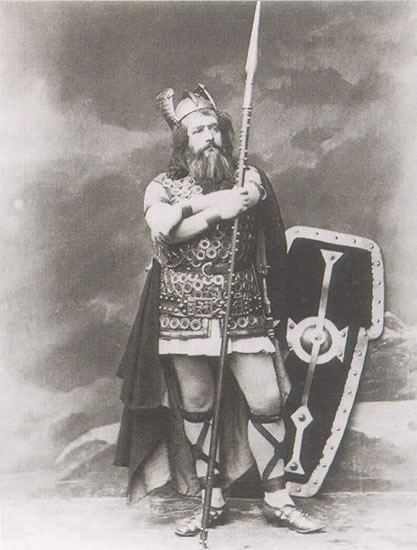 |
Siegfried |
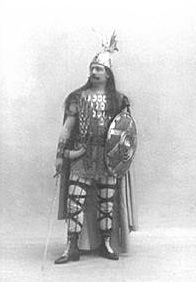 |
Sigurd |
But in the case of Ernest Reyer’s Sigurd, (1884), a French opera that uses the same source materials that inspired Richard Wagner’s Siegfried and Götterdämmerung, there are interesting parallels and divergences that go beyond comparison of their operatic treatment of the text; for there is a nationalist thread running through the material that would indicate a divergence of approach no matter who the composer was.
Unfortunately, while Reyer’s opera was fiercely popular in its day, it is now scarcely known. While Wagner’s Ring is performed worldwide every year, Sigurd has seldom been seen since the 1930’s, and then exclusively in French productions; and as we shall see, there is a good reason for that: the two operas are bound by a common theme that is treated separately but faithfully to each composer’s country and traditions.
Source Material
There are three separate, interwoven aspects to the Sigfried/Sigurd story. One is ancient Norse Mythology, a theology as rich in gods and heroes as that of the Greeks or Romans; Odin (or Wotan), Freia, Thor; we are familiar with them if for no other reason than their names are the roots of the words for the days of the week. The second are their stories, told in a number of epic Eddas such as the Völsunga Saga and Thidreks saga, and the 12th century High German poem known as the Nibelungenlied. But thirdly, these stories are plaited with historical characters from the 8th century, who are given heroic stature as well. Names appear such as Atli (Atilla the Hun), Sigurd, Brynhild and Gunnar. Where history ends and the embroidered saga begins is blurred. Timeless gods and goddesses influence the lives of heroes from A.D. 400's, and political exigencies of the 1100's are subtextual. As we shall see, Wagner's 19th century agenda added yet another layer of control and confusion on the once simple Eddas.
The historical Norsemen in these epics refer to the tumultuous western migration of tribes that expanded into what is now France, Germany, Northern Italy, Ireland, Scandinavia, the Faroe Islands and Iceland, between the time when Rome was sacked by the Visigoths, and the rise of Charlemagne, when the Saxons were converted to Christianity after thirty years of war. Most specifically, the story of Sigurd is built around the defeat of the Burgundians by Flavius Aëtius thanks to Hunnic mercenaries near Worms around the year 436.
In Europe, the culture of the Latins vied for predominance with that of the Norsemen. The Irish, for example, claim Sigurd as the ancestor of Olaf the White, their first king. Certainly for the French, the Merovingian dynasty was a crystallization of Gallic power, and for the Germans, the Saxons and magical tales of the Rhine River was deeply embedded in their culture as a treasured, if dim, past. In England, Anglo-Saxon literature was prevalent until the Norman Conquest in 1066, and even then it took hundreds of years for the French influence to balance out that of the Saxons.
The Norse tales were set down in short, alliterative lines (known in German as stabreim), with swift, brutal action that spoke of heroism, love, honor, and the duty to ones country:
Hon beð broddi gaf blóð at drekka, hendi helfússi, ok hvelpa leysti… |
With a sword-point she gave the bedding blood to drink, with a hand eager for death, and freed the dogs... 1 |
|---|
The tonic sound and accent in Germanic languages occurs usually on the first syllable, making it a language subject to rich alliteration; it was only later that Romance languages, with their more liquid vowels and accents toward the ends of words, allowed the development of rhyming as a poetic gesture in verse. It is no surprise that Reyer’s librettists used an elaborate, rhyming verse for him to set to music; it is appropriate, but very surprising that Wagner’s use of alliterative, rhymeless stabreim in his work harkened back to the "percussive patterning of the words that reinforces their meaning," as observed by the poet Simon Armitage.2
 |
Page from one of the Eddas |
Toward the middle of the 19th century, when many European countries were seeking to identify their own roots and find a unifying base, these thrilling sagas were translated and published in elaborate illustrated editions, and were very popular not only in France and Germany, but in England and Italy as well. Later in the century, William Morris, Edward Burne-Jones and Arthur Rackham made these ancient lays into something of an industry, publishing sumptuously printed, illustrated volumes.
In Germany, the Nibelungenlied was translated into modern German when Wagner was a child; in the 1850's, playwright and poet Christian Hebbel wrote a dramatic trilogy, titled Die Nibelungen that had many parallels to Wagner's treatment, which gestated almost simultaneously. In France an edition by Émile de Laveleye came out in 1861 and was almost immediately taken up by artists as grist for retelling. The poet de Lisle wrote a rather overheated "La Morte de Brunehild" in 1862, and in Germany Emanuel Geibel wrote "Brunhild: A Tragedy from the Nibelung Saga" in 1879.
It is interesting to note that Schumann and Mendelssohn, the two composers whom Wagner excoriated as being ‘superficial’ in his infamous tract "Das Judentum in der Musik" – both contemplated writing an opera based on the Nibelungenleid, but were daunted by how to shape the libretto; and the conductor-composer Heinrich Dorn, whom Wagner intensely disliked, wrote an opera, Die Nibelungen in 1853 which was not a success. Whether consciously or not, Wagner made it clear that he would brook no competition in Germany on this subject.
Development of the Libretti
While the stories of the sagas themselves are difficult to follow and exist in many variants that change spellings, incidents and outcomes, it is ten times more difficult to explain what Richard Wagner did to them to compile his four operas that make up the Ring.
Briefly, Wagner was searching for a myth that would encompass ideas he had about culture, art, love and power. In the 1840’s he began to consult the various Eddas, finding in the story of Siegfried an admirable subject to enlarge upon, and began writing one opera he titled Siegfrieds Tod. He soon thereafter began researching another hero, Friedrich Barbarossa (during whose reign the Nibelungenlied was written), then Buddha, then the Greek warrior Achilles, and then, of all subjects, Jesus of Nazareth. He seems to have worked on all of these simultaneously. Rejecting the others, Siegfried won out, as a final subject, but poetic and musical themes from the other ideas he was working on were assimilated into the Siegfried story, which grew into two operas (Die Junge Siegfried), then three. The idea of a trilogy seemed to be a valid, classic Greek design, but the "satyr play" usually appended by the Greeks on a fourth day was transformed into an introduction—a "Vorabend" that rounded it all off with Das Rheingold. The climax of the tetrology, Siegfrieds Tod, the original concept, became the last opera, Götterdämmerung.
Previous treatments of the Nibelungen story were not lacking in similar form and content to what Wagner eventually used; many earlier treatments in the early 19th century were trilogies, and many had discrete sections called Siegrieds Tod and Die Junge Siegfried, along with sections named Kriemhilds Krage or Kreimhilds Rache (Kriemhild's Revenge), a title that ended up as the second film in the Siegfried films of Fritz Lang in the 1920s. The truly impressive list of derivative works based on these stories is worth the effort to leaf through, if not something that bears careful study.
In Reyer’s case, he also was interested in finding a hero from mythology. The poet Michel Carré (librettist of just about every celebrated French opera of the time, Faust, Roméo et Juliette, Hamlet, Mignon, Paul et Virginie), wrote a draft scenario for Reyer in the 1860’s that was based on the Sigurd stories, and used many of the supernatural elements that Wagner had also used. Most critics are agreed that while Reyer was aware of Wagner’s efforts, Reyer was not trying to compete with him, and later on maintained that at the time he had not heard a note of anything past Lohengrin—indeed, few Frenchman had.3 Reyer had reviewed a concert at which the Prelude to Tristan was performed, and (as we shall see, with Berlioz looking over his shoulder) dismissed it thoroughly.
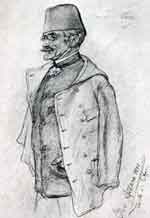 |
Camille DuLocle |
Yet a major shift in poetic strategy occurred when Carré dropped out of the collaboration and was replaced by Camille du Locle, (later assisted by Alfred Blau). Du Locle, whose uncle happened to be the director of the Paris Opéra, had just seen Verdi through the stormy French première of Don Carlos, writing the libretto for the original French version. Du Locle argued that the element of the fantastic was not appropriate to Reyer’s Sigurd: that the story really was an historical one, dealing with the fall of the Burgundian régime, and that the drama was better off played as being among real people than capricious gods and goddesses. He excised the Tarnhelm, Fafnir the dragon, the hoard, the Norns, the Rhine-maidens, even the Ring itself. (He did leave in a few elves and kobolds for the ballet, however.) While the Nordic flavor of the story was preserved, du Locle envisioned the settings to have a more classic appeal to them. Thus, the "magic abode in which [Brunehild] slept in Act II looked more like a baroque palazzo than a magic chateau in Iceland protected by norns and elves."4
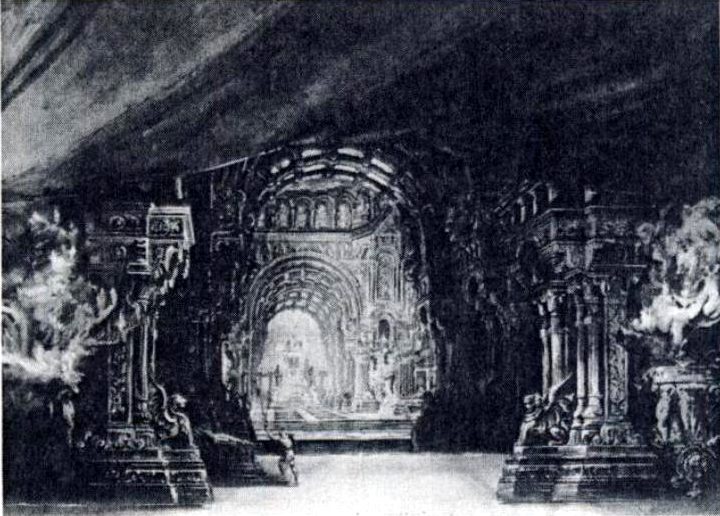 |
|---|
Act II Set from Sigurd |
Other than dyed-in-the-wool Wagnerites, most French critics agreed that this was the better way to construct the story, deriving certain grounding from the historicity of the Merovingians and Burgundians. Henri Fouquier, a noted anti-Wagnerite, wrote that "Odin of course will make us laugh… and in Valhalla, which is his Olympus, when there will be a feast of nectar and ambrosia, we will be overcome with the prosaic odor of beer and smoked sausage."5
There is no doubt that Wagner’s treatment of the material became more and more personal. As Theodor Adorno wrote, "in Wagner’s allegories, everything came to mean the same as everything else. Wibelungs are Nibelungs, the Grail is the Hoard, Friedrich is Siegfried and Siegfried is Christ."6 In fact, the sources become so interchangeable, that according to Fr. J. Owen Lee, "only in Wagner does the dwarf steal the gold at the bottom of the Rhine, protected by three water spirits, or does Erda appear…. The more one rummages about in the sources, the more come comes to see that the best mythic ideas in the Ring came from Wagner’s own imagination"7 and are not to be found in either the Eddas or the Nibelungenlied.
Wagner, who in 1865 wrote out and published the poem of his completed Ring des Nibelungen supposedly before setting a note to it, crafted a work that harkened back to the stabreim of the original, using short alliterative lines:
"Ein edleres Weib ward niegewonnen.
Der Gebichungen Geschlecht,
gaben die Götter ihm Gunst… "8
Du Locle’s verses are written in a consistent, elegant scheme, quite often rhymed abba|cc, time-honored from the days of François Villon:
"Pour conquérir la blanche Valkyrie,
Pour briser ses liens, ô roi, si tu le veux,
Dans les mêmes périls nous combattrons tous deux,
Mais au retour dans ta patrie,
Du sang que près de toi, frère, je verserai,
Tu donneras le prix que je réclamerai. "9
The Composers
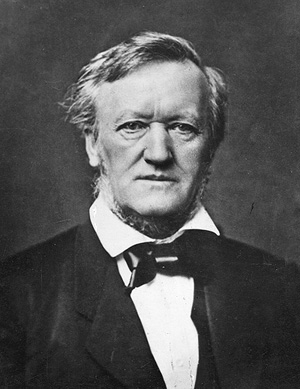 |
Richard Wagner |
Both composers lived through times of upheaval in their own countries: Wagner in the 1849 Dresden uprising through the unification of Germany, from which he had to flee to Switzerland, and Reyer in the 1871 Commune –and both through the Franco-Prussian War. Their individuals operas were rallying points for the opera-going public, in different ways. While Wagner maintained that his operas were apolitical, there is no doubt that their point of view is patently set to pit the materialism of the industrialized world against the gentler and more powerful forces of love and Art. In Reyer’s case, his opera gave an heroic stature to historical characters that was meant to inspire a nationalistic feeling.
The Paris Opéra was never an easy place to get new works performed. Wagner had passed a very difficult time there, when his Tannhäuser was nearly booed off the stage. Almost contemporaneously, Les Troyens, an opera as ambitious as the Ring itself, was struggling to be seen on the boards, written by the great Hector Berlioz (who never did live to see his long opera performed in its entirety). Reyer admired Berlioz as a mentor, and much of Sigurd can be seen as being influenced by the elder composer’s outlook and methods.
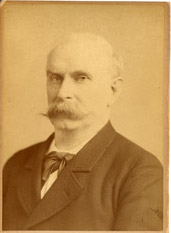 |
Ernest Reyer |
As much as Reyer’s music is a brilliant working within the established French Grand Opera style, it was Wagner and Berlioz who were the true iconoclasts. As a celebrated critic who succeeded Berlioz at the Journal des Débats, Reyer could not ignore the accomplishment of either man, and eventually found himself in the uncomfortable position of having to defend both. And while Berlioz died in 1869, he had made it clear that he could never stomach Wagner’s music, calling Tristan nothing but "a chromatic moan, full of dissonant chords."10 As mentioned above, Reyer continued that point of view, and did so until the French première of Die Walküre, when he admitted Wagner's profound influence on music internationally.
In 1860 Berlioz had published an article on Wagner, citing him almost derisively as the leader of the “music of the future.” Rather than take this as the beginning of a battle royal, Wagner wrote back an open letter to Berlioz that is the model of courtesy, even citing their friendship as a basis for the discussion of art and its meaning. The idea of Wagner’s being the leader of such a movement was a “puerile” idea, he wrote, and thought that Berlioz hadn’t well thought it through. Finally, he stated that “What I have tried to do is demonstrate the possibility of producing a work in which the human spirit can find both the profound and the elevated, accessible to anyone of ordinary intelligence without discussion or relying on criticism.”11
 |
Hector Berlioz the Iconoclast. Note the Cannon. |
Yet the Berlioz connection is an important one, since Sigurd is written in a style that could be thought of as an extension of Berlioz’s, and the success of Sigurd allowed the French public to feel a continuity in their musical culture about which they felt a discomfort placing Berlioz as their hope of music of the future. It was René de Récy who pointed out, oddly enough, that had Berlioz not been such a musical maverick – had he "mocked Bach less, he could have been our Wagner."12
In a radio introduction to a performance of Reyer's Salammbô the announcer makes an extraordinary statement that Reyer, whose original family name was "Rey" (which is true), added the 'er' to have it be more like the name "Wagner." There is no evidence for this, and Reyer's music was being performed and published long before the Wagner controversies in Paris caused a ferment among the critics, meaning Reyer would have had to be enamored of the German composer as far back as 1847, when Rienzi was barely performed in Germany, and unknown in France, making no sense at all. But it is thought-provoking as to why he felt it necessary to change his name, and the idea that it needed more verbal stature does lead one to wonder what the syllable "er" added. Let us recall, however, that these were the days when artist's names were subject to all kinds of playful and long-lasting changes for various reasons. The photographer and balloonist Félix Tournachon, whose nom-de-plume was Nadar, achieved his moniker from his colleagues calling him "Tour-nadar" -- apparently a twist that many of his contemporaries found fashionable in their friends' names. 13In Nadar's case it became his trademark, and his legal family name. So for Rey to be Rey-ar, it is a short hop (and near-homonym) to "Reyer," using the same short-lived fashion.
 |
Rose Caron as Brunehild in Sigurd (1883) |
Despite du Locle’s connection with the Opéra, Sigurd also had a difficult time getting performed. Although completed some time in the 1870’s, Reyer was disconsolate that no theater would perform it, or even consider it without heavy cuts. Parts of Sigurd were performed at concerts, including the finale of Act II in 1873, conducted by the celebrated Jules Pasdeloup, who championed much new French music. Finally, in 1883 Sigurd was mounted at the Théâtre de la Monnaie in Brussels, where it was a great success, then at the Académie Nationale de Musique in Paris the next year, and only later seen at the Paris Opéra, still in a cut version, but was just as successful. Of the new operas to appear at the time, Le Cid, Henry VIII, Samson et Dalilah, and Sigurd stand out as the most performed. The rôle of Brunehild made Rose Caron a star for the rest of her life.
It is well documented that Wagner composed the music for Das Rheingold by 1854, and Die Walküre by 1856. Siegfried, interrupted by work on Tristan and Die Meistersinger, was begun in 1856 and completed in 1874, along with Götterdämmerung. Das Rheingold was first performed in 1869, but thanks to the intense admiration of his patron, Ludwig II, the whole of the Ring des Nibelungen was performed at Bayreuth in 1876.
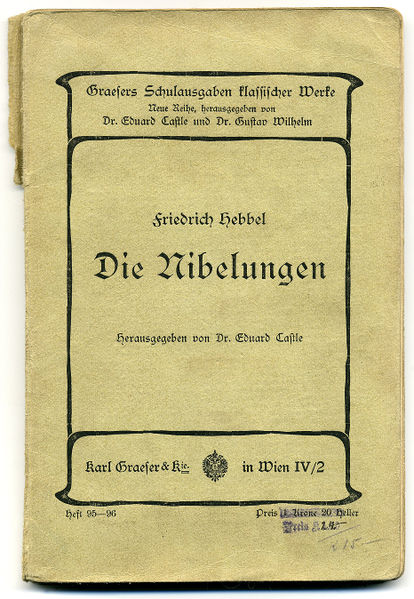 |
Hebbel's Die Nibelungen, 1860 |
It is of interest that officially Götterdämmerung was performed in 1876, and Sigurd eight years later, in 1884, but the works were available almost contemporaneously; the première dates were simply dependent on the interest and availability of theaters—Reyer awaiting the Théâtre de la Monnaie’s consent, and Wagner waiting on the construction of his personal Festspielhaus in Bayreuth. Furthermore, the aforementioned playwright Christian Hebbel's play Die Nibelungen was on theboards long before either opera, and was tremendously successful, presaging both the mysticism of Wagner's treatment and the lyricism of Reyer's. Hebbel did not approve of Wagner any more than Wagner approved of Hebbel.
It is also of note that Wagner had some difficulty completing Götterdämmerung, re-writing the ending six times before being satisfied with it, and Reyer did not complete the last act of Sigurd until just before the première in Brussels. While the character of Sigurd/Siegfried must die, according to the myth, what his death means, and how Brunehild/Brünnhilde reacts is what characterizes the authors’ final vision of the whole piece. In Reyer’s case, du Locle wrote an Apothéose, during which the defunct Sigurd and Brunehild mount a rainbow to Odin’s Valhalla, singing:
"Oublions les maux soufferts,
Pour nous les cieux sont ouverts,
Que nos âmes confondues,
Dans leur ivresse perdues,
Chantent l’hymne solennel
De leur amour éternel...14
--but the scene was cut (although published in the libretto), in favor of the chorus rephrasing the sentiments, thus once again expunging the supernatural. Further, the sight of Attila in the background, among the corpses of Burgundians completed the tableau of bloody reality, as opposed to a journey up a rainbow to the Norse heaven. Wagner’s ending, with a horse and rider leaping into a funeral pyre, the Rhine overflowing, the Rhine-maidens recapturing their gold, the flames catching Valhalla afire and the gods seen therein burning, are perhaps the most alarming stage directions ever written.
The Music
It is in the Ring that Wagner brought his use of "grundthemen" – (base themes), into sharp focus. Eventually these brief musical gestures became known as leitmotivs, or leading themes, and seemed to take on a life of their own, almost like puzzles to solve, well-suited to an extended work that had become, in John Deathridge’s observation, "a parable of riddles and emotional conflict." The themes are almost all very short, and often are not developed musically, although sometimes they accumulate with enormous power, and blossom from one variation to another, where they take on additional "meaning." How much meaning Wagner meant, and how much has been imposed by his enthusiasts is a matter of debate. Father Owen Lee, a perceptive Wagnerian critic, has written that Wagner thought of his "200 or so musical themes as 'motives of memory,' not tags identifying personages or objects" that from their initial simple associations, become charged with additional meaning by the end of the cycle.16
Reyer, who began writing Sigurd in the 1860’s, also used thematic material that repeated, much in the same way. It was obviously something in the air du temps, as we see similar themes repeated for effect in Bizet’s Carmen, Verdi’s La Traviata and I Due Foscari . In 1883, Saint Saëns’s Henry VIII was remarkable for its use of musical motives, rather in the Wagnerian manner. Comte Boselli, writing in 1903, reported that "Wagner was not the first to use the leitmotivs. M. Reyer used them in 1860 in his La Statue, and before that, Meyerbeer made use of them in Le Prophète." 17 Wagner’s genius lay in the pervasive and extensive use of these motives, but certainly he did not claim to have invented them, nor did he use them so obsessively in any other opera of his, than the Ring.
One of the benefits of the leitmotivs is that they can be used to illustrate or magnify what is happening in the instant; but they can also be used as a reminder, or as something a character may be thinking of, even though singing about a totally different subject. Wagner left specific instructions as to how to delineate between these two in performance:
"…when the Valhalla motive is depicting an actual happening it should be delivered in a grand style, slowly and broadly, but when serving as a reminiscence - as for example in Sieglinde's narrative - slightly faster and with accents less pointed ... A fine line must always be drawn between the degree of expression demanded by a present event and a recollected one."18
But truly the motives are seldom subtle, and arguably, quite often unnecessary. While Wagner was making his own rules, a modern audience does tend to tire over use of the leitmotivs in their simplistic state. When they are reminiscences, or when they are woven together and combined, they are more powerful. As Kobbé, in his typical 19th century Guide to the Ring would put it:
"The music [in Götterdämmerung, end of Act I] opens with the abrupt chords of the Hagen Motive; these and the Motive of Compact accompany the Sword Motive, when Siegfried draws Nothung. Phrases of the Pledge of Brotherhood followed by the Brünnhilde, Gutrune and Sword Motives accompany his words; the abrupt Hagen chords lead to the motive of the Nibelung’s Power and Tarnhelmet, which pass into the Brünnhilde Motive…"19
According to George Bernard Shaw, The Ring consists of two-and-a-half music dramas and one-and-a-half grand operas – the break occurring as Siegfried bursts through the wall of fire to get at Brünnhilde.20 Shaw was most interested in the idea of music drama as a new artform, but was equally as interested in what he perceived to be good use of the more historical forms, using duets, choruses, and the like for the remainder of the Ring.
It is interesting to observe that that last "one-and-a-half operas" are the analog to Sigurd, which is not only a Grand Opéra, but "l’opéra à compartiments" (or a "number opera" with closed forms) as well. It was reported that at the first performance of Das Rheingold the audience applauded after Loge’s long discourse in the last act because it seemed like an aria that actually came to an end, begging for applause21 as one would do in a typical number opera. It is also odd that Reyer opposed anyone cutting his Sigurd, which despite its relative brevity still is a formidable three hours (more, with the ballets)—yet he wrote it in a style that has repetitions and recapitulations that certainly could be cut with no loss at all to the continuity.
As for Reyer, his musical motifs are more melodic, some of them as short as Wagner’s, some more extended and developed. For example, comparing Siegfried’s theme to what we presume is that of Sigurd:
 Siegfried
Siegfried
 Sigurd
Sigurd
Two different tempi, two different keys, but they could almost be in counterpoint to each other. What they seem to illustrate is a shared cultural expression of "heroism." The use of upward-rising gestures, the use of dotted rhythms, of the triplet-feel, these are time-honored ways of expressing heroic effort. In fact, as was pointed out by no less astute an observer as Anna Russell, all the Wagnerian motives move upward, "except for Hagen, who is the only fellow with a downward cry, and the only one among all these people wearing a helmet with the horns turning down."22
Both operas have moments that are transcendent, usually when associated with chivalric love. In Sigurd’s case, the melody is singular, and the most memorable in the opera. An excerpt from the extended passage:

Sigurd, Act II
Rising to a great forte, it is pure and unexpected bliss, sung by the tenor. We hear it once in the orchestra during the prelude; again as an underscore when Sigurd refers to his love for Hilda (deflected from his love of Brunehild by a wicked philtre), and finally as the climax of the aria, "Esprit gardiens" in the second act. The build-up is intentional and very effective.
In Götterdämmerung, the final bars contain a motive that is of interest because Wagner didn’t label it; since it is the final statement of the tetrology, there must be some tremendous import to it; some critics call it "Brünnhilde’s transcendent love" or "The Expiation Motive." The idea that pure music expresses not only Brünnhilde’s indescribable emotions but is a language in itself, is striking, and perhaps the most radical innovation of The Ring.

Götterdämmerung, Act III
Just as in Reyer, we have heard this melody before, once sung by Brünnhilde, and several times underscoring her final diatribe and immolation. But refreshingly, it has only been heard a very few times in the tetrology, and has a maximum impact because of it.
What is important to note is that Wagner’s use of grundthemen in the Ring is unique in its method of deriving one motive from another (the love themes all seem related; the dwarf themes all come from the same song-book), and the almost obsessive interweaving of them to embroider his story musically. There are times when the motives overlap and repeat until they become like Celtic knots, or the over-elaboration of visual motifs on a page of the book of Kells. It is an apt conceit to use in this instance, and Wagner never quite used it the same way again.
Reyer, on the other hand, was setting a poem that he insisted was crafted by du Locle to move the plot along without Italianate ritornellos or cabalettas; and indeed there are times in Sigurd when a closed-form aria seems to have ended, but the orchestra continues, bringing along the next aspect of the story with it. While it is more difficult to appreciate Reyer’s achievement, because it is not as polarizing as Wagner’s, Reyer’s is nonetheless considerable, when compared to contemporary French operas, such as Hérodiade, Lakmé, Manon, and Le Roi Malgré Lui. It was Adolphe Julien who said that on the day after the première of Sigurd that he realized he’d seen a work that was "important for the musical history of France."23
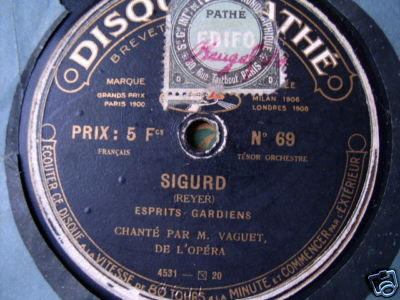 |
Early Pathé recording from Sigurd |
A final word about the comparison of musical treatment: Wagner eschewed the aria, duet and chorus, which made his music drama more cohesive, but the core to Reyer’s arias, shorn of elaboration or extensions, are ideal for the concert hall and later on, phonograph recordings. Very little of Wagner was recorded in the early days of the phonograph, simply because he was so long-winded that little could fit onto a standard 3 minute cylinder or 4-minute shellac disc. As early as 1902, Paris Opéra celebrities were recording for Pathé the various airs from Sigurd. Wagner on disc was usually "Senta's Ballad" or the shorter expressions in the earlier operas. This deficiency of early recording was poignantly illustrated by Lionel Mapleson, who privately recorded cylinders during many live Metropolitan Opera performances of Wagner in the years 1902-1904 (conducted by Luigi Mancinelli), when almost every selection begins in medias res, and is yanked from the mandrel long before the end, as the supply of wax on his cylinder runs out.
Legacies
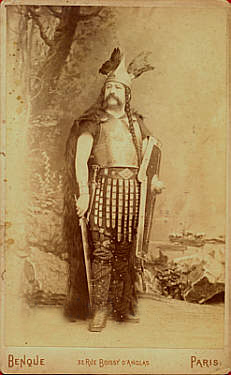 |
Gresse as Sigurd |
For a brief while, Sigurd was the French redoubt against Wagner’s Ring. From the reviews, the French seemed to be proud to have a work that was so very Gallic and competitive with the German titan who was sweeping Europe, inciting one young woman to wonder what the fuss was about a performance of Wagner’s Siegfried at the Paris Opéra in 1902, since "it was merely a re-working of
Sigurd."4
In 1903, Comte J. Boselli wrote in a contemporary music review that Wagner’s Siegfried "had not killed, as you might have supposed… the Sigurd of M. Reyer. We have begun to see it again, not in the Opéra archives, but in Lyons, Marseille, Bordeaux, where its beauty speaks for itself—and this Sigurd is a success."25
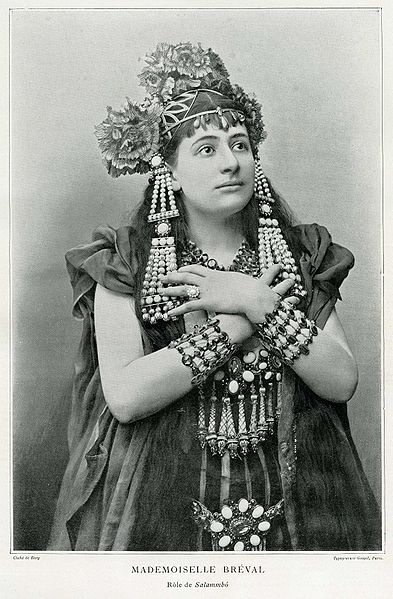 |
Breval as Reyer's Salammbô |
After 1893, when Die Walküre was successfully staged at the Paris Opéra, Reyer admitted that the Wagnerian era had arrived in France, saying that he "glanced sadly at the past, but looked hopefully toward the future, and to decline with grace," apologizing for his previous excoriation of Wagner. Indeed, Reyer became a proponent of staging Wagner’s work in French, as long as it was part of a mixture, programming Mozart, Gluck, Spontini, and Berlioz.27 Reyer wrote only one more opera, Salammbô, which was almost as successful as Sigurd. Salammbô (also with a libretto by du Locle), was admired for its further abandonment of closed forms, pointing toward more of the gesamtkunstwerk of Wagner.28
In the 1920’s, Adolphe Julien wrote that "Siegfried and Götterdämmerung, which seem to be fierce rivals to Sigurd are performed in Paris without slaying each other. At our Opéra there is room for two Siegfrieds and two Brunehilds."29
Of course the Wagner juggernaut did not stop, performed in German, French, and Italian (especially in America, under Italian conductors and impresarios). Luigi Mancinelli, one of the great Italian wagneristas, wrote that Wagner, in his opinion, did not found a school, and "was an isolated genius that one cannot follow or imitate… But the forms of his last works, The Mastersingers, Tristan and Isolde, The Nibelungen, Parsifal – these represent the true invented operatic form" without arias or duets, that can serve as models for operas of the future.30 Even when all things German were shunned, during the First World War, performances did occur in America, but in Italian. Said Boselli: "Wagnerism is on the decline; but not the works of Richard Wagner."31 While the 19th century critic Lawrence Gilman said that Wagner, since his death, has been little imitated—and called Reyer’s operas "dull"—he also said of Wagner’s work, that "as [Walter] Pater prophesied about the poetry of Rosetti, more torches will be lit from it than even enthusiasts imagined."32
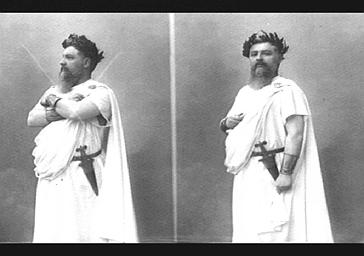
Jean Bartet as Le Grand Prêtre in Sigurd
Sigurd is worth seeing on the stage again, as are so many French operas that have fallen into neglect and are seen only rarely (and only in France). Its beauties lie in its melodies, its combination of Grimm’s fairy tale and grimmer tales of battle and bloodshed. While both Wagner and Reyer are acquired tastes, requiring a mental shift in gears to appreciate, we have forgotten how to get into the gear to appreciate Sigurd. We find its ‘reality-based’ myth a little too shallow, existing on the stage for our entertainment, but not penetrating to our deeper consciousness.
The Ring, however, seems to transcend the quotidian through its use of myth, elements of which were carefully selected and controlled by its author. Father Lee believes its story is about the "voluntary death of a god" and is about how that transforming act leads to "the next evolutionary development of human nature... The Ring can be thought of as taking place not only in the natural landscape of the rivers and mountains covered by fir trees (the way Wagner wanted it on stage) and not only in a 19th century industrialized Europe endangered by greed and competing materialism … but in that inner-landscape which is Wagner’s and mine and yours (the way Wagner eventually suggested the way we see it)."33 It is a darker vision, one that seems to have lasted longer by actually saying less, letting our own experiences, fears, and desires fill in the blanks.
Footnotes
2. Armitage, Simon. Sir Gawain and the Green Knight, introduction, p. 13 {back}
3. Huebner, Steven. French Opera at the Fin de Siècle, p. 186 {back}
5. Le Monde Illustré, 20 June, 1885 {back}
6. Quoted in Deathridge, John. "The Ring: An Introduction" {back}
7. Lee, Fr. James Owen. Wagner's Ring: Turning the Sky 'Round, p. 20 {back}
8. Wagner, Richard. Götterdämmerung, Act II, sc. 1v; vocal score, p. 177 {back}
9. Du Locle et Blau, Sigurd, Act I; libretto, p. 15 {back}
10. Lockspeiser, Edward. "The Berlioz-Strauss Treatise on Instrumentation," p. 37 {back}
11. Reproduced in Georges Servières, Richard Wagner Jugé en France, p. 3 {back}
12. De Récy, La Revue Bleue, 1893, quoted in Huebner, Op. Cit., p. 172 {back}
13. Nadar, Félix [Tournachon]. Quand J'étais Photographe, 1864 {back}
14. Du Locle. Sigurd libretto, p. 66 {back}
15. Deathridge, Op. Cit. {back}
16. Lee, Op. Cit., p. 113 {back}
17. Boselli, Comte J. Le Carnet, vol. xv, Jan-Feb 1903; p. 461 {back}
18. Porges, Heinrich. Wagner: Rehearsing the Ring. {back}
19. Kobbé, Gustav. How to Understand Wagner's Ring. p. 147 {back}
20. Shaw, George Bernard. The Perfect Wagnerite, p. 62 {back}
21. Magee, Bryan. The Tristan Chord, p. 161 {back}
22. Russell, Anna. I'm Not Making This Up, You Know. {back}
23. Julien, Adolphe. Ernest Reyer, p. 74 {back}
24. Quoted in Heubner, Op. Cit., p. 185 {back}
25. Boselli, Op. Cit., p. 461 {back}
26. Julien, Adolphe. Op Cit., p. 93 {back}
27. Quoted in Huebner, Op. Cit., p. 173 {back}
28. Julien, Adolphe. Op. Cit., p. 83 {back}
30. Mancinelli, Luigi. Epistolario, p. 74 {back}
32. Gilman, Lawrence. Aspects of Modern Opera, p. 124 {back}
33. Lee, Fr. James Owen. Op. Cit., p. 95 {back}
References
Boselli, Comte J. "Scène Opéra" in Le Carnet: Revue Mensuelle Illustré, vol. XV, Jan – Feb. 1903, Paris, p. 461
Bruneau, Alfred. Musiques, D’Hier et de Demain. Paris: Bibliothèque-Charpentier, 1900.
Danton, Annina Periam. "Hebbel's Nibelungen, its Sources, Method and Style" Doctoral thesis, faculty of Philosophy, Columbia University, 1906.
Deathridge, John. "The Ring: An Introduction." In Das Rheingold. Hamburg: Deutsche Grammophon, 1989.
Drondee, Ursula, trans, and ed. The Poetic Edda, vol. 1. Heroic Poems. Oxford: Clarendon Press, 1969.
Du Locle, Camille, and Alfred Blau. Sigurd, Livret. Paris: Tresse & Stock, 1888.
Gilman, Lawrence. Aspects of Modern Opera, Estimates and Inquiries. London: The Bodley Head, 1909.
Grimm, Gunter. Die literarische Rezeption des Nibelungenstoffes 18. 2. 2008 quoted in http://www.goethezeitportal.de/index.php?id=rezeption_nibelungen
Hervey, Arthur. Masters of French Music. London: Osgood, McIlvaine & Co., 1894.
Huebner, Stephen. French Opera at the Fin de Siècle. New York: Oxford University Press, 1999.
Jullien, Adolphe. Ernest Reyer (series "Les Musiciens Célèbres"). Paris: Henri Laurens, n.d., ca. 1923.
Kobbé, Gustav. How to Understand Wagner’s Ring of the Niebelung. London: William Reeves, 1918.
Röpe, Georg Reinhard. Die moderne Nibelungendichtung. Hamburg: Otto Meisner, 1869.
Lee, Fr. J. Owen. Wagner’s Ring: Turning the Sky Round. NY: Summit Books, 1990.
Lockspeiser, Edward. "The Berlioz-Strauss Treatise on Instrumentation." Music and Letters. Oxford: Oxford University Press, 1969
Magee, Bryan. The Tristan Chord. NY: Henry Holt and Co., 2000.
Mancinelli, Luigi. Mariani, Antonio, ed. Epistolario. Pisa: Akademos, 2000.
Nadar, Félix (Tournachon). Quand J'Étais Photographe. New York: The Arno Press, 1979 [Flammarion, 1899]. See also http://bit.ly/bwrj6X.
Porges, Heinrich, Jacobs, Robert, trans. Wagner: Rehearsing the Ring. Cambridge: Cambridge University Press, 1983.
Reyer, Ernest. Sigurd, piano/vocal score. Paris: Heugel et Cie, 1884.
—— Salammbô, piano/vocal score. Libretto by Camille du Locle. Paris: Heugel et Cie, 1888.
Russell, Anna, and Janet Vickers Russell, ed. I'm Not Making This Up, You Know: An Autobiography. Toronto, Canada: MacMillan of Canada, 1985
Shaw, George Bernard. The Perfect Wagnerite, 3rd edition. New York: Brentano’s, 1911.
Wagner, Richard. Dusk of the Gods (Götterdämmerung), piano/vocal score. New York: G. Schirmer, 1904.
—— On Conducting (Über das Dirigien,1887). Trans. Edward Dannreuther. NY: Dover 1989.